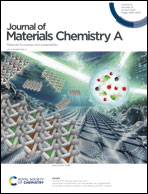Non-classical electrostriction in calcium-doped cerium oxide ceramics†
Abstract
Oxygen-defective metal oxides, e.g., acceptor-doped CeO2, demonstrate exceptionally large electrostrictive responses compared to state-of-the-art electromechanically active ceramic materials. Recent investigations focus on trivalent acceptor (A3+) doped ceria and surmise that giant electrostriction on these compounds depends on the electroactive polarizable elastic dipoles associated with electronic defects in the lattice, e.g., oxygen vacancies  and polarons. Similarly, to relaxor piezoelectrics, electromechanical responses in doped-ceria strictly depend on the applied field frequency, i.e., time-dependent, revealing a complex interplay between the electro-chemo-mechanic effect in the materials and a loss of properties above 1–10 Hz. This work demonstrates the electromechanical properties of divalent (A2+) calcium-doped ceria (CDC) polycrystalline ceramics with various doping levels (Ce1−xCaxO2−x, x = 0.025–0.15). All the CDC compounds illustrate a steady and high electrostrictive strain coefficient (M33) value exceeding 10−18 m2 V−2 across frequencies between 10−1 and 103 Hz. Notably, the M33 is slightly influenced by the nominal oxygen vacancy concentration, CaO segregation, and the microstructure. These key findings unveil a new form of electromechanical effects in calcium-doped ceria that are rigorously stimulated by the strong electro-steric interaction of
and polarons. Similarly, to relaxor piezoelectrics, electromechanical responses in doped-ceria strictly depend on the applied field frequency, i.e., time-dependent, revealing a complex interplay between the electro-chemo-mechanic effect in the materials and a loss of properties above 1–10 Hz. This work demonstrates the electromechanical properties of divalent (A2+) calcium-doped ceria (CDC) polycrystalline ceramics with various doping levels (Ce1−xCaxO2−x, x = 0.025–0.15). All the CDC compounds illustrate a steady and high electrostrictive strain coefficient (M33) value exceeding 10−18 m2 V−2 across frequencies between 10−1 and 103 Hz. Notably, the M33 is slightly influenced by the nominal oxygen vacancy concentration, CaO segregation, and the microstructure. These key findings unveil a new form of electromechanical effects in calcium-doped ceria that are rigorously stimulated by the strong electro-steric interaction of  pairs.
pairs.



 Please wait while we load your content...
Please wait while we load your content...